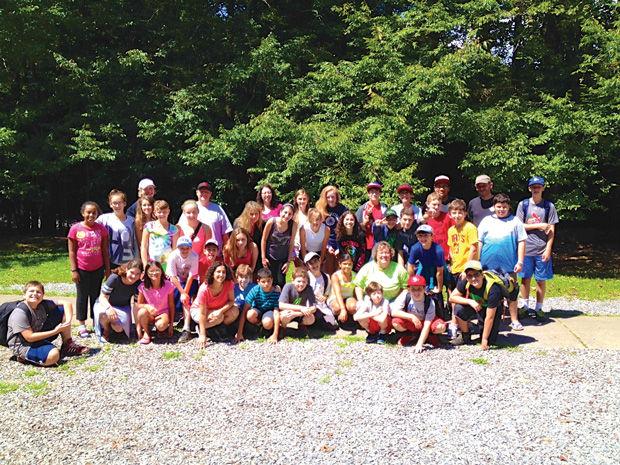Students learn science, conservation during national park visit
Published September 3, 2014
Sixth-grader Sela Roth may not have been sitting at a desk last week but she was still in a classroom – one as big as all outdoors.
“It is one thing to read it out of the textbook but we really got to experience it,” said the 11-year-old student at Saul Mirowitz Jewish Community School. “That’s one thing about Mirowitz that I love because you actually do stuff to learn about it. You don’t just see it.”
What Sela and 34 other middle school students saw was the Great Smoky Mountains thanks to a three-day field trip that allowed them to visit one of the most popular national parks in the country. Falling along the North Carolina/Tennessee border, the range is renowned for its natural scenery and the picturesque mist, which lends the region its name.
The experience, which took place at the Treemont Institute inside the park, included a number of activities including participation in a salamander monitoring project, exploration of a stream for invertebrates and discussion of the different types of plant life at different elevations.
Most notable was an eight-mile hike through the mountains, something that Rick Schmidt, middle school coordinator and science teacher, said caused a bit of apprehension among some students but quickly became the highlight of the whole enterprise.
“They were just worried about whether they could do it and if they would be able to accomplish it,” he said. “When they came off the mountain, they were like, ‘I can’t believe I just hiked eight miles. I was able to do this.’”
But the event was about more than just great scenery and a refreshing climb in the mountains. Schmidt said the idea was to connect youngsters with the environment and the importance of conservation and sustainability. Immediately upon their return, students began working on lessons related to their trip. They even started developing strategies to help with conservation efforts at Mirowitz itself, reviewing everything from food waste to electricity and paper usage at the school.
“It fits in with our educational philosophy beautifully,” said Cheryl Maayan, head of school. “We want to bring learning to life for our students in every way. During the middle school years, it is especially important for us to direct the students toward important issues.”
In fact, this is the third in a series of three annual field trips designed to illuminate social justice matters. The idea took root when Mirowitz formed in 2012 from its two predecessor institutions. Previous events have featured journeys to an Arkansas ranch to examine poverty and hunger and a sojourn to Memphis to hear about civil rights. Next year, the three-year cycle is set to begin again so that each student will be able to experience each trip by the time he or she graduates from eighth grade.
“We want them to be a little unsettled about how easy it is for us to help the earth and how we’re not doing enough,” said Maayan. “We want them to be passionate leaders and show others how simple it is for us to improve the way we are behaving so the earth will be here for our grandchildren. It is not just about a trip. It is about building ethical leaders for our future which is our vision here at Mirowitz.”
Aura Kavadlo, middle school language arts teacher, said that the kids really seemed to gain a deeper sense of what they can do to help the environment and make a difference.
“I think they also enjoyed the struggle of climbing a mountain,” she said of the hike, which featured a one-mile solo stretch for students to explore on their own. “But they also appreciated nature in a new way. I felt like nature wasn’t what they thought it was. It is not just some trees or some birds. It is something that can challenge a person.”
“We made it come alive. For them, that was really powerful,” she added. “Bringing nature to life made them have new respect for it.”
The children seem to agree.
Karyn Lisker, 12, said that she was amazed at her own reaction when the group encountered a rattlesnake.
“I’m very terrified of snakes,” said the seventh grader, “and I was surprised that it wasn’t very scary. The naturalist made us feel that it really wouldn’t do anything to us unless we would attack it.”
Does this mean she has a new appreciation for snakes?
“Not necessarily,” she laughed. “I just felt calmer about it.”
Eleven-year-old Lucas Bernstein said that he definitely will waste less resources in the future and hopes to participate in recycling paper products.
“It was a really good experience,” he said. “It taught me a lot and I had a lot of fun.”
He was also glad to get to know his classmates better.
“I really liked the eight-mile hike because we got to bond a lot,” said the sixth grader. “We got to go on a solo hike and really experience nature.”
Maayan said that’s another benefit of such an extended field trip.
“They become part of one bigger community and their friendships with other students cross the lines of the grade levels,” said Maayan, who went on the journey herself. “Even the students will tell you that is one of the things they love most about these trips.”
Sela, who briefly got to slide down a waterfall during the experience, called the initiative a once-in-a-lifetime event.
“I think it will help me understand the stuff we learn about more because I’ve actually been there,” she said. “It was really beautiful and nothing like I’ve ever experienced before.”
















